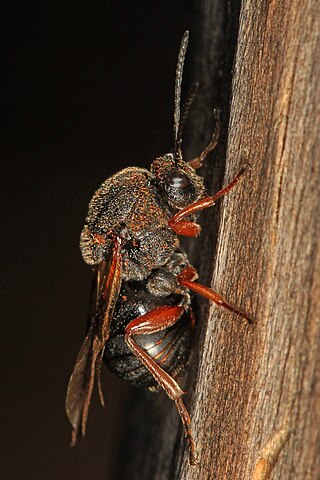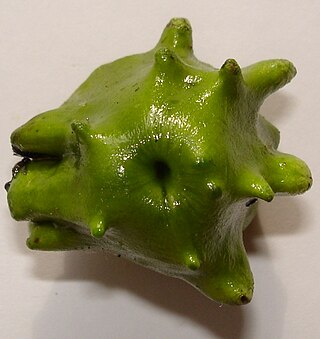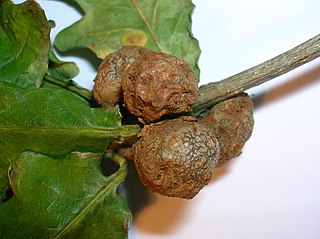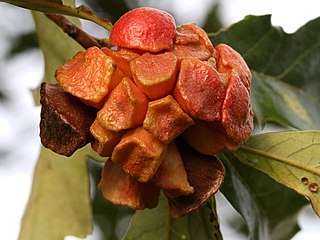
Gall wasps, also traditionally calledgallflies, are hymenopterans of the family Cynipidae in the wasp superfamily Cynipoidea. Their common name comes from the galls they induce on plants for larval development. About 1,300 species of this generally very small creature are known worldwide, with about 360 species of 36 different genera in Europe and some 800 species in North America.

Andricus quercuscalicis is a gall wasp species inducing knopper galls.

Andricus kollari, also known as the marble gall wasp, is a parthenogenetic species of wasp which causes the formation of marble galls on oak trees. Synonyms for the species include Cynips kollari, Andricus quercusgemmae, A. minor, A. indigenus and A. circulans.

Andricus foecundatrix is a parthenogenetic gall wasp which lays a single egg within a leaf bud, using its ovipositor, to produce a gall known as an oak artichoke gall, oak hop gall, larch-cone gall or hop strobile The gall develops as a chemically induced distortion of leaf axillary or terminal buds on pedunculate oak or sessile oak trees. The larva lives inside a smaller hard casing inside the artichoke and this is released in autumn. The asexual wasp emerges in spring and lays her eggs in the oak catkins. These develop into small oval galls which produce the sexual generation of wasps. A yew artichoke gall caused by the fly Taxomyia taxi also exists, but is unrelated to the oak-borne species. Previous names or synonyms for the species A. fecundator are A. fecundatrix, A. pilosus, A. foecundatrix, A. gemmarum, A. gemmae, A. gemmaequercus, A. gemmaecinaraeformis and A. quercusgemmae.

Cola-nut galls develop as a chemically induced distortion of leaf axillary or terminal buds on pedunculate oak or sessile oak trees, caused by the agamic gall wasp Andricus lignicola which lays single eggs within leaf buds using their ovipositor. A previous name or synonym for the species A. lignicola is A. lignicolus and A. venheurni.

Andricus is a genus of oak gall wasps in the family Cynipidae.

Andricus grossulariae is a gall wasp species inducing agamic acorn cup galls on oak tree acorn cups and sexual phase galls on catkins. Synonyms include Andricus fructuum, Andricus gemellus, Andricus intermedius, Andricus mayri and Cynips panteli.

Andricus quercuscalifornicus, or the California gall wasp, is a small wasp species that induces oak apple galls on white oaks, primarily the valley oak but also other species such as Quercus berberidifolia. The California gall wasp is considered an ecosystem engineer, capable of manipulating the growth of galls for their own development. It is found from Washington, Oregon, and California to northern regions of Mexico. Often multiple wasps in different life stages occupy the same gall. The induced galls help establish complex insect communities, promoting the diversification in niche differentiation. Furthermore, the adaptive value of these galls could be attributed their ecological benefits such as nutrition, provision of microenvironment, and enemy avoidance.

Andricus aries is a species of gall-forming wasps, in the genus Andricus. The species was named by the French entomologist Joseph-Étienne Giraud, in 1859. It is commonly found in eastern Europe and during the 21st century has spread to western Europe.

Andricus curvator is a gall wasp which forms chemically induced leaf galls on oak trees and has both agamic and sexual generations. Agamic and sexual generations usually form two distinct galls on oak trees, but in the case of A. curvator there are six galls; the sexual generation usually on the leaf, occasionally in a twig or catkin, and the agamic generation in a bud. The wasp was first described by Theodor Hartig, a German biologist, in 1840 and is found in most of Europe.

Andricus inflator is a species of gall-forming wasps, in the genus Andricus, which has a sexual and an asexual generation, producing two different galls. The wasp was named by the German biologist Theodor Hartig, in 1840 and is found in Europe.
Andricus infectorius is a species of gall-forming wasp. The species was named by the German biologist Theodor Hartig, in 1843 and is found in Europe.
Andricus mukaigawae is a species of gall wasp native to southeastern Asia. It creates galls on the buds and leaves of oak trees. The galls are sometimes used by other gall wasps unable to create galls of their own, with both species sharing the gall.
Synergus japonicus is a species of gall wasp in the family Cynipidae. Whereas most gall wasps create the galls in which they live, Synergus japonicus is an inquiline species, living in the gall created by another species of wasp. It is native to Japan, China and Russia.

Andricus quercusstrobilanus, the lobed oak gall wasp, is a species of gall wasp in the family Cynipidae, found in North America. The quercus in its specific name is the genus name for oak, while "strobilus" is derived from the Greek strobilo which means "cone", a reference to the cone shape of the gall; thus the gall is sometimes called pine cone oak gall.

Andricus parmula, also known as the disc gall wasp, is a species of gall-forming wasp in the genus Andricus. It induces galls in a wide selection of oak species, especially white oaks, and including hybrids. The galls are disc-shaped, up to 3 mm in diameter, and pale with red streaking. Adult females emerge in April. The galls induced by A. parmula superficially resemble the galls of Andricus gigas,Andricus viscidus, and newly identified species called the "plate gall wasp" and the "orange-cap gall wasp" by Richard Russo. Galls induced by this wasp have been documented in Oregon and California on the Pacific coast of North America.

Andricus pattersonae, also known as the plate gall wasp, is a species of gall-forming wasp in the genus Andricus. Their hosts are among the white oaks grouping of oaks, with blue oak being common.

Andricus bakkeri, also known as the pinched leaf gall wasp, is a relatively uncommon species of gall-inducing hymenopteran. They produce pink leaf galls on Oregon oaks and scrub oaks. The distribution of this wasp is California and Oregon in North America.

Trichoteras is a genus of gall-inducing Hymenopteran that has several species formerly classed as Andricus. Trichoteras characteristics include antennae with 10 flagellomeres. An entomologist writing in 2018 stated that "is questionable that Heteroecus and Trichoteras should be synonymized with Andricus" in regard to a proposed taxonomic reorganization of 2002. Ronald A. Russo in Plant Galls of the Western United States moves species like the golden oak apple wasp from Andricus to Trichoteras, while acknowledging the previously accepted binomials. William Harris Ashmead first defined this genus in 1897.

Andricus stellaris, the sunburst gall wasp, is a fairly common species of cynipid wasp that produces galls on blue oaks and Oregon oaks on the Pacific coast of North America. The wasp oviposits on the underside of leaves, between the lateral veins; the larval chamber is the brightly colored spot at the center of the gall. The chamber is surrounded by a crystalline structure.

















